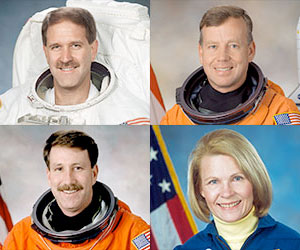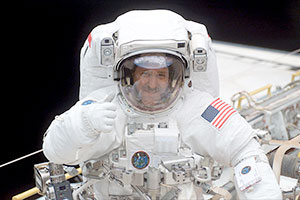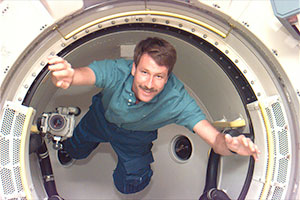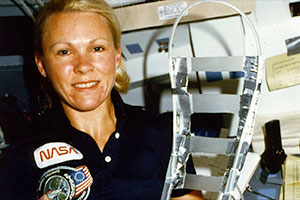February 12, 2015 — The U.S. Astronaut Hall of Fame will honor four space shuttle astronauts this spring as it marks 25 years since its founding.
Spacewalker John Grunsfeld and Rhea Seddon, who was one of NASA's first female astronauts, will be enshrined alongside space shuttle commanders Steven Lindsey and Kent Rominger during a May 30 ceremony at the Kennedy Space Center in Florida. The four astronauts, who are the 14th class of shuttle veterans to be added to the Hall, will bring the total number of members to 91.
"This year marks the historic 25th anniversary of the Hall, which was conceived in 1989 by the Mercury astronauts," Kennedy Space Center Visitor Complex officials stated on Thursday (Feb. 12). "These four astronaut heroes will join the ranks of well-known explorers, including Alan Shepard, Neil Armstrong and Buzz Aldrin."
Combined, Grunsfeld, Lindsey, Rominger and Seddon flew onboard 18 shuttle missions between 1985 and 2011.
Grunsfeld, who today is the NASA associate administrator for science, launched five times into space, logging more than 58 days in orbit, including spending almost 60 hours on eight spacewalks.
After making his first flight in 1995 onboard an astronomy-dedicated mission (STS-67) and visiting Russia's space station Mir two years later (STS-81), Grunsfeld helped to service and upgrade the Hubble Space Telescope on his last three flights (STS-103, 109 and 125). His final mission in 2009 was the last to visit the orbiting observatory.
"This is a really tremendous adventure that we've been on, a very challenging mission," Grunsfeld said as he ended his final spacewalk. "Hubble isn't just a satellite, it's about humanity's quest for knowledge."
Lindsey never flew to Hubble, but he led the final mission of shuttle Discovery (STS-133), the orbiter that deployed the venerable space telescope.
"Houston, Discovery, for the final time, wheels stop," said Lindsey after the shuttle came to a rest on March 9, 2011.
Also a veteran of five space shuttle flights, Lindsey first flew into orbit on board Columbia (STS-87) in 1997. On his second mission (STS-95) a year later, he piloted a crew of "six astronaut heroes and one American legend," the latter referring to original Mercury astronaut John Glenn making his celebrated return to space.
Lindsey also helped deliver the airlock for the International Space Station (STS-104) and led NASA's second return to flight mission (STS-121) after the loss of shuttle Columbia in 2003. A former chief of the astronaut office, Lindsey is today Sierra Nevada's senior director for space exploration systems.
Lindsey inherited the chief astronaut title from Rominger, who also flew five missions.
Rominger, who is today a vice president with Orbital ATK, made his first two flights as the pilot of shuttle Columbia (STS-73, 80) on a pair long-duration missions dedicated to microgravity research.
"The consistency we're doing in the research is paying off. There is going to be a major breakthrough in one of these fields from doing science in orbit," Rominger said in 1995.
Rominger flew once more as pilot (STS-85) and then led two missions to the International Space Station (STS-96, 100), delivering supplies and helping to install the station's Canadarm2 robotic arm.
Seddon took control of the original Canadarm on her first shuttle mission (STS-51D) in 1985, attempting to trigger a satellite's start-up sequence with a makeshift "flyswatter" device attached to the manipulator's end.
"The flyswatter became the symbol of our flight, and when we got off the flight we were handed flyswatters," Seddon said.
Selected with NASA's first six female astronauts in 1978, Seddon's three shuttle flights preceded all of Grunsfeld's, Lindsey's and Rominger's trips into orbit. A physician, her second and third missions (STS-40, 58) were dedicated to the study of life sciences in space.
Seddon, who is married to 2003 Astronaut Hall of Fame inductee Hoot Gibson, is today a consultant to healthcare institutions and recently finished writing her memoirs, "Go for Orbit."
Grunsfeld, Lindsey, Rominger and Seddon were selected for induction by a committee of Hall of Fame astronauts, NASA leaders, flight directors, historians and journalists in a process that was managed by the Astronaut Scholarship Foundation.
To be eligible, astronauts must be U.S citizens and have made their first spaceflight at least 17 years prior to their induction year. In addition, nominees need to be a NASA-trained commander, pilot or mission specialist who orbited the Earth at least once.
For more information about attending the Astronaut Hall of Fame induction ceremony, see kennedyspacecenter.com. |
|

2015 class of Astronaut Hall of Fame inductees: John Grunsfeld, Steven Lindsey, Kent Rominger and Rhea Seddon. (NASA/cS)

STS-109 mission specialist John Grunsfeld gives a "thumbs up" from inside space shuttle Columbia's payload bay. (NASA)

STS-104 commander Steven Lindsey looks over a checklist from his seat on the flight deck of space shuttle Atlantis. (NASA)

STS-73 pilot Kent Rominger floats through the tunnel connecting space shuttle Columbia's cabin and its science module. (NASA)

STS-51D mission specialist Rhea Seddon poses with a makeshift "flyswatter" device to be attached to the robotic arm. (NASA) |
